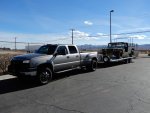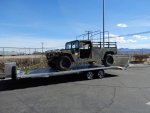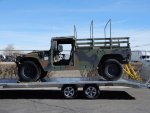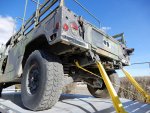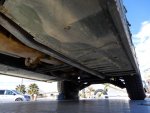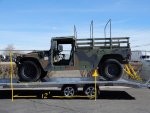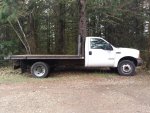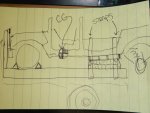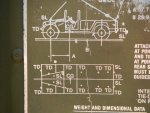When you place the timbers, they will all jut out without being attached to each other. That means only 2 - 4 timbers will support the rear of the truck. ALSO they will be like cantelevers, so if the front of the timbers are not attached to the trailer, the fronts will fly up making a wedge shape that will cause the truck to slide backwards. If the giant lever cracks the timbers in the middle, same thing.
Pulling her with a 6000 lb rated towbar is a better idea BUT you might still blow a tire, as these vehicles have cracked Goodyears. There is a posted warning about Goodyears on GovPlanet.
If you use a short trailer with timbers, I hope you get pulled over and tickets and stopped, because what you are planning is reckless and unnecessary and stupid.
Rent a freakin' trailer or pay to get her shipped.
As I think you're not gonna listen...
View attachment 760370
I have no plans to haul it on a short trailer, any trailer I might use would be longer than the HMMWV and rated for more than the 6k lbs load that would be necessary. Short trailers are just a pain to haul in the first place, and much more prone to issues when towing.
What I've been discussing is having it placed on the back of an F450 flatbed truck, which happens to be rated for 7k lbs load centered above the drive axle, so the weight and center of gravity of the HMMWV would not be in any way incorrect or illegal to haul. What I've been trying to discuss is whether or not there are any technical issues with hauling the HMMWV by using large timbers to support it, as a 12 foot flatbed isn't long enough to provide support to the rear of the HMMWV.
I've pretty much scrapped the idea of setting the HMMWV on long timbers underneath the wheels. As you said, one crack in the timbers and things go sideways fast.
The second plan was to figure out all the dimensions needed and use lag bolts to secure the timbers together so that it was a single, solid mass and unable to move. Then several straps would be run to secure the timber frame to the deck of the truck. Blocks would be placed crossways on top of the main timber frame, and also secured by lag bolts. From what I see, the frame really only needs to be blocked at a couple points for this to work, which would be directly behind the front suspension and directly in front of the rear suspension. The rear blocking point would be about the 12 foot mark as labeled above, so the main timber frame would be supported by the flatbed deck, and not need to extend past it. This means no cantilevering, and no worries about the timber frame developing cracks, as it will be fully supported. At that point the rear wheels (yes, I know they are heavy, but I've dealt with semi truck wheels so it's not an issue to me) would be removed and secured towards the front of the flatbed just behind the front wheels of the HMMWV.
Let me put this out there. It is common practice when driving a semi and hauling equipment that needs the wheels removed for either size or weight purposes to use heavy timbers to support the weight of the equipment while transporting. When properly secured the equipment does not move, it does not just randomly fall off and kill innocent people minding their own business. My main question has to do with whether or not blocking the frame of the HMMWV at several points will do any type of damage to it. Considering they've been using a forklift at most of the sale yards to move these around, it doesn't appear that there will be any issues with this method.
The reasons you mentioned above about the tires on these being old, as well as several threads I've read on the forum about flat towing, and the one guy who got a HMMWV with no gear oil in the hub (from a private seller) are the main reasons why I have zero plans to use a tow bar and do a flat tow. The risk/reward ratio is too high in my opinion.
And yes, at this point I'm still very much planning to haul the HMMWV on the back of my flatbed truck because nobody has yet posted a reason as to why it will not work. Your cantilever and broken timber comments are good points, and taking them into consideration there won't be any cantilevering involved, as it's both unnecessary, and would actually raise the center of gravity, where heavy timbers under just the frame between the front and rear suspension does not have that issue/risk.
So again, current plan is to use heavy timbers (6x12s, on edge), bolted together to form a box. That box would then be securely strapped to the flatbed truck. On top of that box of timbers would be multiple cross pieces, probably either 4x6 or 6x6, maybe even as much as 6x12, to support the frame in several places, one just behind the front suspension, one in the middle, and one just in front of the rear suspension (or in other words, along the flat portion of the frame in the middle of the HMMWV). The block directly in front of the rear suspension would be right about the 12 foot mark as labeled above by DREDnot. This means it would be supported by the end of the flatbed. At this point the rear suspension of the HMMWV would be hanging off the back of the flatbed. I'd most likely remove the wheels to reduce the weight hanging on the rear suspension, as well as moving the center of gravity just a little further forward (which is unnecessary as the CG is already at or in front of the truck's rear axle, but I don't see it doing any harm)The HMMWV would be secured by multiple chains and multiple straps to prevent it from moving. While 4 is the required number of straps/chains to secure this load, I plan to take at least twice that number to secure the load, and will use every single one. I do have lights to attach to the tail of the HMMWV as well as marker flags as required by law.
So here is a new question if anyone is willing to check for me. What is the measured distance between the frame rails at the points just behind the front suspension and just in front of the rear suspension where the frame levels off and becomes straight? And viewed directly from the side, how far in front of or behind the edge of the tire does the frame level off? If it's 6 inches or less I can use some 6x12 timbers laid flat, 7 feet long, and brace them against the tire to help keep things from moving.
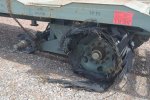
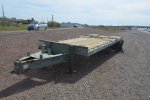 for AZs abandoned vehicle fees, fines, storage etc.
for AZs abandoned vehicle fees, fines, storage etc.
 for AZs abandoned vehicle fees, fines, storage etc.
for AZs abandoned vehicle fees, fines, storage etc.


